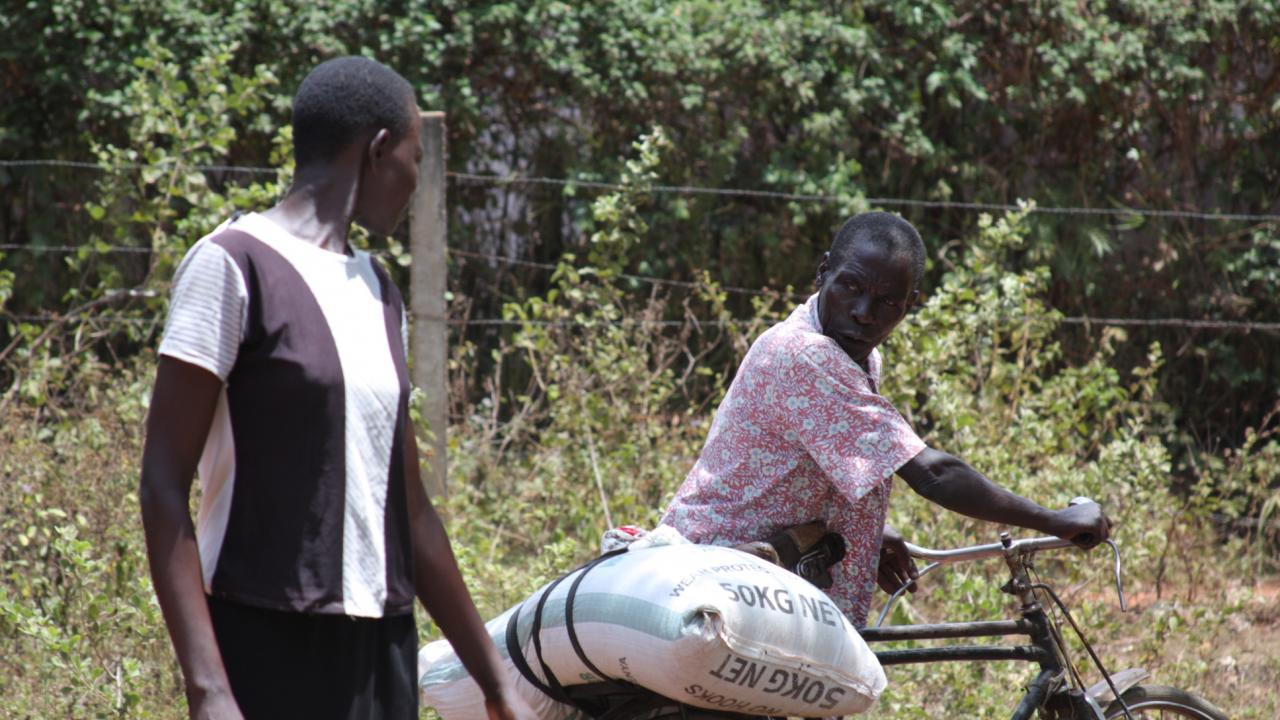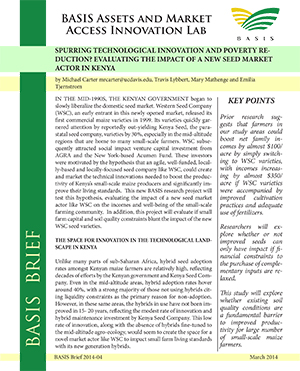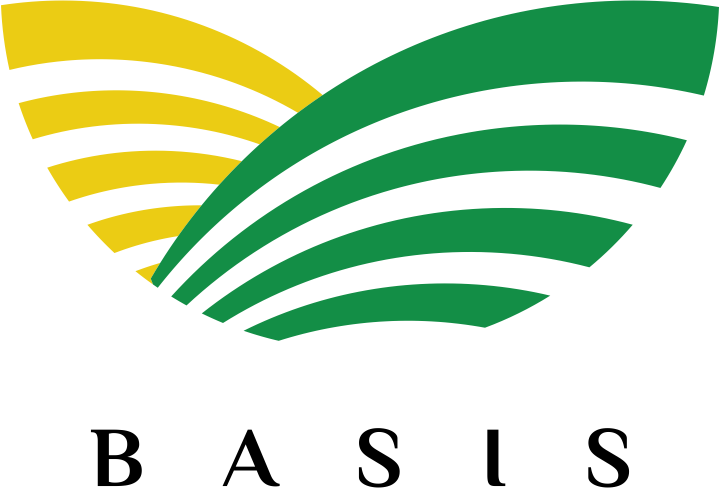
In the mid-1990s, the Kenyan government began to slowly liberalize the domestic seed market. Western Seed Company (WSC), an early entrant in this newly opened market, released its first commercial maize varieties in 1999. Its varieties quickly garnered attention by reportedly out-yielding Kenya Seed, the parastatal seed company, varieties by 30%, especially in the mid-altitude regions that are home to many small-scale farmers.
Key points
- Prior research suggests that farmers in our study areas could boost net family incomes by almost $100/ acre by simply switching to WSC varieties, with incomes increasing by almost $350/ acre if WSC varieties were accompanied by improved cultivation practices and adequate use of fertilizers.
- Researchers will explore whether or not improved seeds can only have impact if financial constraints to the purchase of complementary inputs are relaxed.
- This study will explore whether existing soil quality conditions are a fundamental barrier to improved productivity for large number of small-scale maize farmers.
 WSC subsequently attracted social impact venture capital investment from AGRA and the New York-based Acumen Fund. These investors were motivated by the hypothesis that an agile, well-funded, locally-based and locally-focused seed company like WSC, could create and market the technical innovations needed to boost the productivity of Kenya’s small-scale maize producers and significantly improve their living standards.
WSC subsequently attracted social impact venture capital investment from AGRA and the New York-based Acumen Fund. These investors were motivated by the hypothesis that an agile, well-funded, locally-based and locally-focused seed company like WSC, could create and market the technical innovations needed to boost the productivity of Kenya’s small-scale maize producers and significantly improve their living standards.
This new BASIS research project will test this hypothesis, evaluating the impact of a new seed market actor like WSC on the incomes and well-being of the small-scale farming community. In addition, this project will evaluate if small farm capital and soil quality constraints blunt the impact of the new WSC seed varieties.
The Space for Innovation in the Technological Landscape in Kenya
Unlike many parts of sub-Saharan Africa, hybrid seed adoption rates amongst Kenyan maize farmers are relatively high, reflecting decades of efforts by the Kenyan government and Kenya Seed Company. Even in the mid-altitude areas, hybrid adoption rates hover around 40%, with a strong majority of those not using hybrids citing liquidity constraints as the primary reason for non-adoption. However, in these same areas, the hybrids in use have not been improved in 15- 20 years, reflecting the modest rate of innovation and hybrid maintenance investment by Kenya Seed Company. This low rate of innovation, along with the absence of hybrids fine-tuned to the mid-altitude agro-ecology, would seem to create the space for a novel market actor like WSC to impact small farm living standards with its new generation hybrids.
Analysis of the 2010 data from the Tegemeo Agricultural Policy Research and Analysis (TAPRA) project reveals that farms in our study areas (the mid-altitude segments of Western/Nyanza provinces and Central Province) lag far behind the technological frontier for maize productivity. 90% of farmers in Western/Nyanza province and 50% of farmers in the Central province report maize yields that are less than 10 and 20 bags of maize/acre, respectively. Mean maize yields are about 5 bags/acre in Western/Nyanza provinces and 13 bags/ acre in Central province.
In contrast, field trials of WSC hybrids in these mid-altitude regions resulted in yields of 30-40 bags/acre. Using the local 2011 maize price as a reference point, these vast yield differences suggests that farmers in our study areas could boost net family incomes by almost $100/acre by simply switching to WSC varieties, with incomes increasing by almost $350/acre if WSC varieties were accompanied by improved cultivation practices and adequate use of fertilizers. With per-capita living standards standing below a dollar per-day for farmers not using hybrid seeds, income increases of the magnitude promised by WSC hybrids are large enough to allow these families to escape severe poverty.
These potential impacts are large and exciting, and clearly motivated the decision of social impact investors to boost the capability of WSC to produce and distribute its improved seed varieties. However, the key question is of course whether or not these potential impacts can be realized in practice, and whether or not ancillary interventions are required to make them happen.
Can Improved Seeds Reduce Extreme Poverty?
Unfortunately, there are a number of reasons why these potential productivity and poverty reduction impacts of WSC varieties may not take place. First, as is often observed, farmers’ returns to new technologies are lower than those implied by field trials. Second, we have accumulating evidence that the returns to improved seed varieties are highly heterogeneous amongst farmers, as are returns to more general small farm development strategies. Especially in terms of poverty reduction impacts, this heterogeneity is extremely important as the same average treatment effect, but with different impact distributions, will imply different levels of poverty reduction.
Third, we know that many farmers are tightly liquidity constrained, making it difficult for them to purchase the matching inputs required to reap the full genetic potential of improved, locally adapted varieties. During the initial stages of fieldwork, farmers reported buying fertilizer a few pounds at a time over the course of the year whenever they had spare cash. At planting time, they would use remaining funds to purchase only enough improved seeds to plant that area for which they had incrementally accumulated adequate fertilizer. The greater the number of farm families bound by such liquidity constraints in our study area, the less likely it is it that WSC seeds will work.
Finally, there is debate about the fraction of small farmers whose soils are fertilizer responsive and who hence who can benefit from an improved seed fertilizer package. Low soil organic matter and acidic soils found in parts of western Kenya are a further part of the complex of factors that may conspire to limit the expected impacts of even innovative seed market actors like WSC.
Western Seed Expansion Allows Randomized Evaluation
Evaluation of the socio-economic impacts of new, market-based agricultural technologies is challenging because it can be difficult to create the classical experimental design in which a treatment group has access to a technology to which an otherwise identical control group does not. However, until recently, WSC’s modest seed production capacity limited its geographic footprint, meaning that there are large numbers of farmers outside of the areas where WSC has traditionally marketed its product, and who thus lack information, experience and perhaps trust in WSC hybrids.
These heretofore uninformed farmers present themselves as an ideal lab for a randomized evaluation of the impacts of WSC. Powered by infusions of new capital, WSC is rapidly expanding its production capacity and is poised to move into these areas it was previously unable to supply. Working in collaboration with WSC, the BASIS research team has devised a multi-year research strategy designed to answer the key questions concerning the impacts of WSC. The strategy builds upon WSC’s standard business model. When WSC enters new districts where its products are largely unknown, a marketing team establishes demonstration plots on local farmers’ land, around which they define spatially explicit learning zones. At the beginning and end of the rainy season, WSC holds field days and distributes free trial seed packets to attending farmers. WSC does not expect farmers to adopt new varieties until they have witnessed successful demonstration plots, and have experimented with the seed on their own land.
This business model keeps a learning window open long enough to permit rigorous evaluation. In keeping with this model, prior to the March-May 2013 long rains, WSC identified more potential learning zone areas than they could actually service in the western and central study areas. Together with the WSC marketing team, rsearchers selected districts where (a) the agro-ecological conditions were suitable for WS varieties and (b) WSC had low market share. We then selected 18 matched pairs from the set of demo plots within those districts based on the characteristics listed in the text, and we randomly selected one zone in each pair.
One zone in each pair was then chosen at random for exclusion from the standard WSC marketing program. WSC has agreed to refrain from marketing in these 18 control zones for two years, while it will proactively operate in the 18 treatment zones, establishing demonstration plots, distributing seed packets and conducting field days.
“Powered by infusions of new capital, WSC is rapidly expanding its production capacity and is poised to move into these areas it was previously unable to supply. Working in collaboration with WSC, the BASIS research team has devised a multi-year research strategy designed to answer the key questions concerning the impacts of WSC.”
Table 1 illustrates the experimental design for the WSC evaluation. The columns represent the basic design to study the impact of WSC seed varieties on farm productivity and family wellbeing. Within each learning zone, 3 villages were selected at random for the study. Within each village, on average 17 households were selected at random for survey, yielding a total sample size of 1800 households.
Following this design, in February 2013 WSC presented an information session and distributed 250-gram sample packs of seeds to all study households in the treatment zones, giving these farmers the opportunity to plant a small experimental plot with Western Seed hybrids during the 2013 long rains. Baseline data collected in later 2013 and early 2014 revealed that nearly all farmers had planted their experimental seed packets in 2013. Information from those farmers on the yields obtained with the trail seeds is being used as part of an exercise to determine farmers’ willingness to pay for WSC hybrids.
Testing Capital and Soil Quality Constraints
As discussed above, access to quality seed varieties is not the only barrier to improving small-farm maize productivity. In late 2013, the research team contracted with CropNuts—a Nairobi-based soil analysis firm—to undertake a complete analysis of soil samples collected from study farmers’ fields. CropNuts also provided individually tailored soil amendment recommendations for each farmer. In early 2014, the research team then held lotteries in each village in the Western region sample. Half the study farmers in each village won an allotment of specially blended fertilizer adequate to cover one-acre of maize. Winners were immediately rewarded with bags of the appropriate fertilizer mix.
This fertilizer gift removes the liquidity or capital constraint that farmers report inhibits their ability to profitably employ higher-yielding seeds and escape the cycle of low maize productivity and low income. As shown in the Table above, this liquidity/fertilizer intervention constitutes a second dimension of the study. Only farmers in the Western study area were included as central region farmers tend to enjoy higher incomes and appear to be less capital-constrained in general.
This second dimension of the intervention will allow the research team to determine the severity of liquidity constraints. Comparing Group B with Group D farmers will allow us to determine whether or not the impacts of WSC hybrids are blunted by liquidity constraints. If impacts for Group D farmers are larger, then we will learn something important about the sequence of interventions needed to reduce poverty through improved seeds.
Finally, the information on soil fertility we have collected will allow a unique window into the long-standing issue about returns to improved seeds and fertilizer given existing soils in Western Kenya.
Looking Forward
AGRA and others have invested heavily in seed systems throughout sub-Saharan Africa with the expectation that new market players like Western Seed Company can create new prospects for growth throughout the region, especially for the small-scale farm sector. The model is clearly replicable, but the key question is whether it really works and adds value to what can be achieved by multi-national and other traditional market participants.
The research sketched out here exploits the opportunity created by the rapid expansion of WSC’s capacity and ability to create well-defined treatment and control groups. We also explore whether or not improved seeds can only have impact if financial constraints to the purchase of complementary inputs are relaxed, as well as whether existing soil quality conditions are a fundamental barrier to improved productivity for large number of small-scale maize farmers. The project also complements the work being done by USAID’s Kenya Maize Development Program. The on-theground players, which include WSC itself as well as its impact investors, are keen to understand the impacts of WSC’s hybrid maize program. Whatever this research ultimately finds, we are confident that its results will not be ignored.
For Further Reading
Carter, M., Laajaj, R., Yang, D., 2012. The Impact of Voucher Coupons on the Uptake of Fertilizer and Improved Seeds: Evidence from a Randomized Trial in Mozambique. American Journal of Agricultural Economics (forthcoming, 2013).
Carter, M., Toledo, P., Tjernstrom, E., 2012. Investing in Small-Farm Productivity: Impact Dynamics and Heterogeneity in Nicaragua. Working paper.
Mathenge, M.K., Smale, M., Olwande, J., 2012. The Impact of Maize Hybrids on Income, Poverty, and Inequality among Smallholder Farmers in Kenya (Working Paper).
This report is made possible by the generous support of the American people through the United States Agency for International Development (USAID). The contents are the responsibility of the Feed the Future Innovation Lab for Assets and Market Access at UC Davis and do not necessarily reflect the views of USAID or the United States Government.
